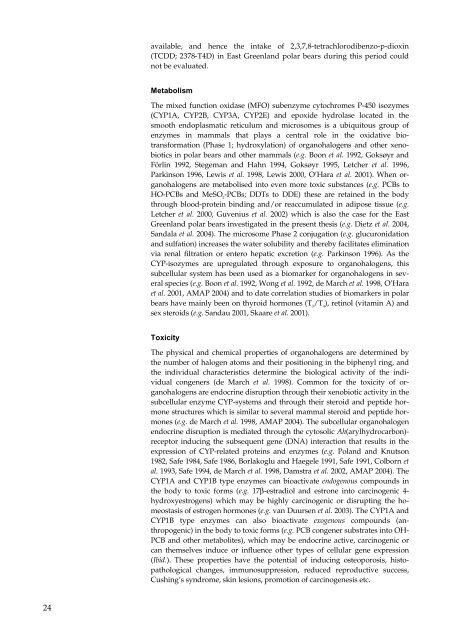Organohalogen concentrations and a gross and histologic ...
Organohalogen concentrations and a gross and histologic ...
Organohalogen concentrations and a gross and histologic ...
Create successful ePaper yourself
Turn your PDF publications into a flip-book with our unique Google optimized e-Paper software.
24<br />
available, <strong>and</strong> hence the intake of 2,3,7,8-tetrachlorodibenzo-p-dioxin<br />
(TCDD; 2378-T4D) in East Greenl<strong>and</strong> polar bears during this period could<br />
not be evaluated.<br />
Metabolism<br />
The mixed function oxidase (MFO) subenzyme cytochromes P-450 isozymes<br />
(CYP1A, CYP2B, CYP3A, CYP2E) <strong>and</strong> epoxide hydrolase located in the<br />
smooth endoplasmatic reticulum <strong>and</strong> microsomes is a ubiquitous group of<br />
enzymes in mammals that plays a central role in the oxidative biotransformation<br />
(Phase 1; hydroxylation) of organohalogens <strong>and</strong> other xenobiotics<br />
in polar bears <strong>and</strong> other mammals (e.g. Boon et al. 1992, Goksøyr <strong>and</strong><br />
Förlin 1992, Stegeman <strong>and</strong> Hahn 1994, Goksøyr 1995, Letcher et al. 1996,<br />
Parkinson 1996, Lewis et al. 1998, Lewis 2000, O’Hara et al. 2001). When organohalogens<br />
are metabolised into even more toxic substances (e.g. PCBs to<br />
HO-PCBs <strong>and</strong> MeSO 2 -PCBs; DDTs to DDE) these are retained in the body<br />
through blood-protein binding <strong>and</strong>/or reaccumulated in adipose tissue (e.g.<br />
Letcher et al. 2000, Guvenius et al. 2002) which is also the case for the East<br />
Greenl<strong>and</strong> polar bears investigated in the present thesis (e.g. Dietz et al. 2004,<br />
S<strong>and</strong>ala et al. 2004). The microsome Phase 2 conjugation (e.g. glucuronidation<br />
<strong>and</strong> sulfation) increases the water solubility <strong>and</strong> thereby facilitates elimination<br />
via renal filtration or entero hepatic excretion (e.g. Parkinson 1996). As the<br />
CYP-isozymes are upregulated through exposure to organohalogens, this<br />
subcellular system has been used as a biomarker for organohalogens in several<br />
species (e.g. Boon et al. 1992, Wong et al. 1992, de March et al. 1998, O’Hara<br />
et al. 2001, AMAP 2004) <strong>and</strong> to date correlation studies of biomarkers in polar<br />
bears have mainly been on thyroid hormones (T 3 /T 4 ), retinol (vitamin A) <strong>and</strong><br />
sex steroids (e.g. S<strong>and</strong>au 2001, Skaare et al. 2001).<br />
Toxicity<br />
The physical <strong>and</strong> chemical properties of organohalogens are determined by<br />
the number of halogen atoms <strong>and</strong> their positioning in the biphenyl ring, <strong>and</strong><br />
the individual characteristics determine the biological activity of the individual<br />
congeners (de March et al. 1998). Common for the toxicity of organohalogens<br />
are endocrine disruption through their xenobiotic activity in the<br />
subcellular enzyme CYP-systems <strong>and</strong> through their steroid <strong>and</strong> peptide hormone<br />
structures which is similar to several mammal steroid <strong>and</strong> peptide hormones<br />
(e.g. de March et al. 1998, AMAP 2004). The subcellular organohalogen<br />
endocrine disruption is mediated through the cytosolic Ah(arylhydrocarbon)receptor<br />
inducing the subsequent gene (DNA) interaction that results in the<br />
expression of CYP-related proteins <strong>and</strong> enzymes (e.g. Pol<strong>and</strong> <strong>and</strong> Knutson<br />
1982, Safe 1984, Safe 1986, Borlakoglu <strong>and</strong> Haegele 1991, Safe 1991, Colborn et<br />
al. 1993, Safe 1994, de March et al. 1998, Damstra et al. 2002, AMAP 2004). The<br />
CYP1A <strong>and</strong> CYP1B type enzymes can bioactivate endogenous compounds in<br />
the body to toxic forms (e.g. 17β-estradiol <strong>and</strong> estrone into carcinogenic 4hydroxyestrogens)<br />
which may be highly carcinogenic or disrupting the homeostasis<br />
of estrogen hormones (e.g. van Duursen et al. 2003). The CYP1A <strong>and</strong><br />
CYP1B type enzymes can also bioactivate exogenous compounds (anthropogenic)<br />
in the body to toxic forms (e.g. PCB congener substrates into OH-<br />
PCB <strong>and</strong> other metabolites), which may be endocrine active, carcinogenic or<br />
can themselves induce or influence other types of cellular gene expression<br />
(Ibid.). These properties have the potential of inducing osteoporosis, histopathological<br />
changes, immunosuppression, reduced reproductive success,<br />
Cushing’s syndrome, skin lesions, promotion of carcinogenesis etc.

















